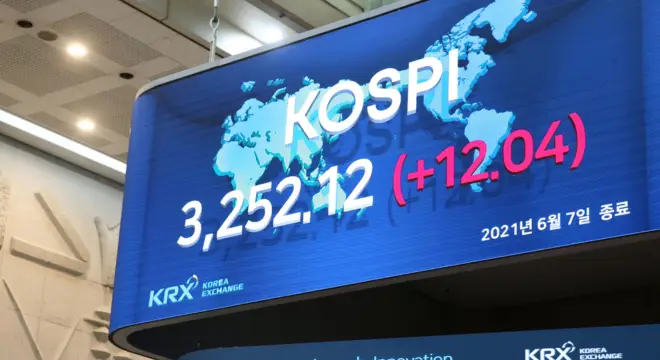What comes to mind when you think of South Korea? Is it K-Pop idols breaking YouTube records, or the unstoppable wave of K-dramas dominating Netflix? But here’s another question: did you know that South Korea’s stock market has recently outperformed every other major global index? And one more—why has Kospi suddenly become the hottest stage in Asia, drawing not just fans but billions of dollars from investors?
The answer lies in sweeping reforms, political change, and the movement to eliminate the longstanding “Korea Discount.” With battles over corporate governance, trends in global investment, and new narratives of propagated South Korean transformation, the transformation of South Korea’s finances is becoming as aesthetically pleasing as its cultural exports. Let’s unpack just how Kospi has emerged as the latest national anti-hero.
The Rise of Kospi: A Record Rally
The stock market in South Korea has been, for the year 2025, a global headline. The Kospi index has soared more than 40%, surpassing its peers in Tokyo, Taipei, and even Wall Street. Domestic and international investors are flocking in, looking to capitalize on reform and growth.
Several factors are driving the Kospi:
- Political Stability – The election of President Lee Jae Myung gave way to months of political instability and restored some certainty.
- Corporate Governance Reform – Structural changes are being made to remediate investor complaints that have existed for decades.
- Global Rate Cuts – Lower interest rates across Asia and the U.S. have made stocks more attractive.
- Tech Boom – AI-driven demand has boosted giants like Samsung Electronics and SK Hynix.
But while these short-term sparks matter, the bigger story is President Lee’s determination to fix the system itself.
Ending the “Korea Discount”
For decades, Korean companies have traded at lower valuations compared to their peers in Japan or Taiwan. This phenomenon, called the “Korea Discount”, is rooted in weak corporate governance, excessive family control of chaebols (the massive conglomerates like Samsung, Hyundai, LG), and frequent conflicts between majority and minority shareholders.
President Lee’s reforms aim to change this narrative. By setting strict rules that strengthen shareholder rights and transparency, Korea hopes to convince the world that its market deserves fairer pricing.
Key Governance Reforms
The landmark reforms passed in mid-2025 are among the boldest in Korea’s corporate history:
- Independent Boards: Companies must now have at least one-third independent directors (up from one-quarter).
- Voting Power Limits: Large shareholders, especially chaebol families, cannot use more than 3% of their voting rights in appointing audit committee members.
- Annual General Meetings Go Hybrid: Large firms are required to allow online participation, making shareholder involvement easier.
- Duty to All Shareholders: Directors must now legally act in the interest of all investors, not just the family groups controlling the company.
These rules were not passed without resistance. Chaebols fought hard, but the government pushed through, determined to open a new chapter for Korea Inc.

Why It Matters: The Chaebol Challenge
The reforms directly target Korea’s most controversial corporate practice: family domination of chaebols.
Examples are plenty:
- At Samsung, disputes with shareholders persist, culminating in lawsuits and jail time for its chairman.
- At LG Chem, minority shareholders claimed it’s stripping value away for the spin-off of LG Energy Solution before its spectacular IPO.
Such ongoing battles harm investor trust and perpetuate the Korea Discount. Minority shareholders finally have a louder voice and stronger rules to back them up.
Lessons from Japan
Korea is not inventing the wheel. It is deriving its reforms from the Japanese reform of corporate governance that incentivized firms to put shareholders first, improve efficiencies, and release hidden value. The outcome has been a sustained rally of the stock market in Tokyo, tempting foreign interest once again.
Still, Korea’s price-to-book ratio remains far below Japan and Taiwan, highlighting both the opportunity and the challenge ahead.
Investor Response: A Wave of Capital
So far, investors are optimistic. Since May 2025, foreign investors have poured $11.5 billion into Korean stocks. Domestic enthusiasm is also strong—nearly 30% of the Korean population now invests in equities.
Global banks are revising forecasts upward. For example, Morgan Stanley has raised its Kospi target to 4,000 in the next 12 months. That would push valuations to levels slightly higher than Asia’s post-2008 averages. It doesn’t erase the Korea Discount completely, but it’s a significant step toward narrowing the gap.
Risks and Roadblocks
Although the suggested reforms are exciting, experts remind us that the ramifications will depend on the actual implementation of the reforms.
- Companies may find ways to circumvent any new requirements (for example, by holding a surprise extraordinary meeting so they don’t have to comply with new rules).
- Tests of enforcement will eventually work their way into the courts in Korea, where case law has yet to play out.
- Some chaebols may be less cooperative in ways that can inhibit the reforms.
In short, the laws are good on the surface but take a better look at how they will work in practice.
Beyond Governance: Other Growth Drivers
While reforms grab the headlines, several external factors also fuel the Kospi’s rally:
- AI and Tech Demand: Samsung and SK Hynix are key suppliers for global AI hardware, benefiting from the technology wave.
- Monetary Policy: Rate cuts by the U.S. Federal Reserve and Asian central banks have encouraged equity buying.
- Global Investor Sentiment: With China’s growth uncertain, many see South Korea as a safer, reform-driven alternative in Asia.
Together, these drivers ensure that the Kospi’s surge isn’t built on governance alone.
Looking Ahead: Kospi 5,000?
President Lee has made a bold campaign promise: pushing the Kospi beyond the 5,000 mark. Achieving that will require:
- Sustained reforms that hold up under legal and corporate pressure.
- Further steps like eliminating treasury shares, which drag valuations down.
- Continued foreign inflows and domestic participation.
If Korea succeeds, its stock market could become not just an Asian leader but a global benchmark.
Conclusion: A New Face of Korea
South Korea has already dazzled the world with its music, dramas, and pop culture. Now, it is showcasing another star—its financial markets. The Kospi’s rally reflects not just a temporary boom but a structural attempt to fix deep-rooted flaws.
Of course, challenges remain. Reforms must be enforced, chaebols will resist, and global conditions can always shift. Yet, for the first time in decades, investors are beginning to believe that the “Korea Discount” may not be permanent.
So, the next time you think about South Korea, don’t just picture a K-Pop concert. Imagine the trading floors of Seoul, buzzing with optimism, as the Kospi marches toward 5,000. The region is changing, and the world is watching.


